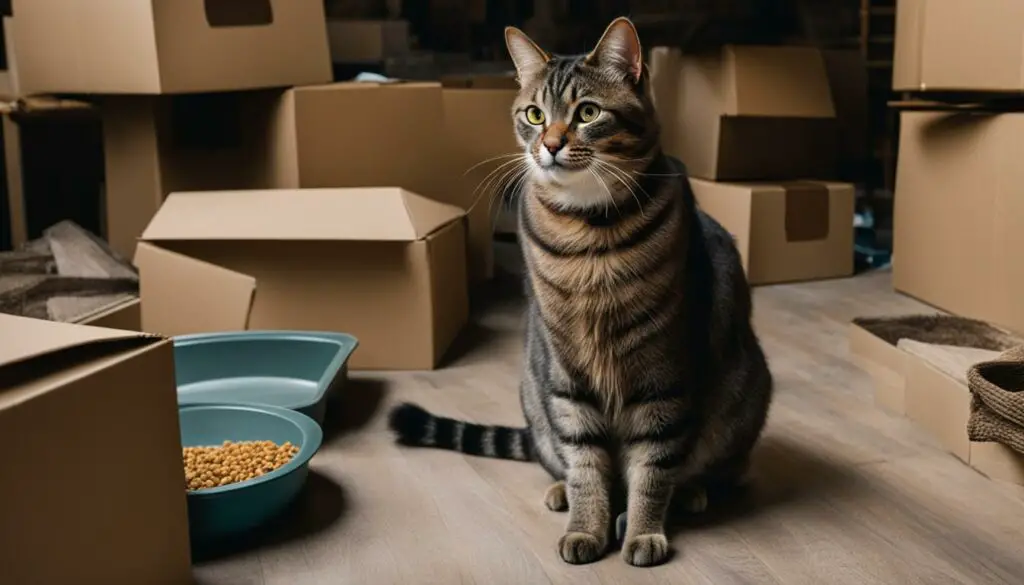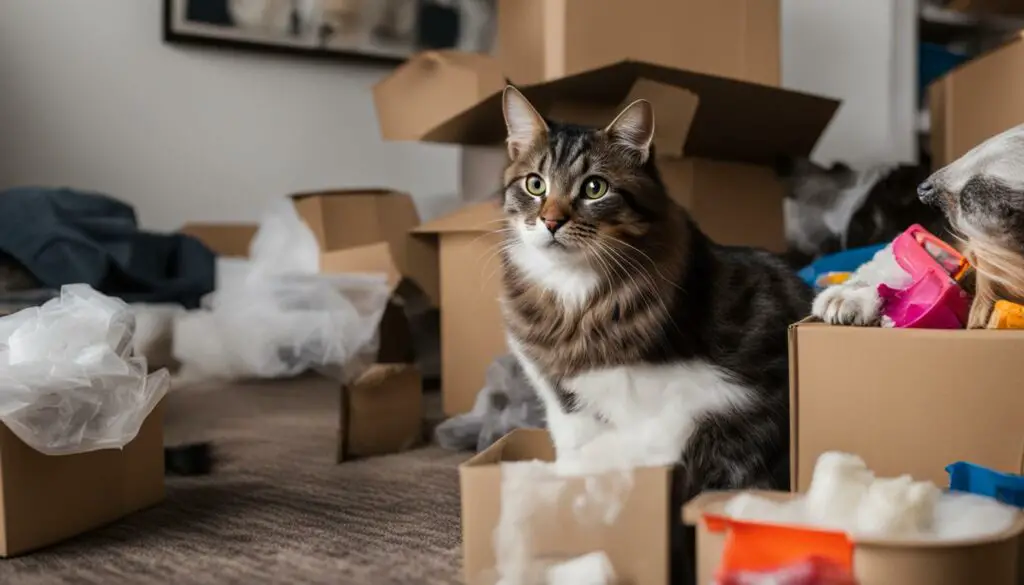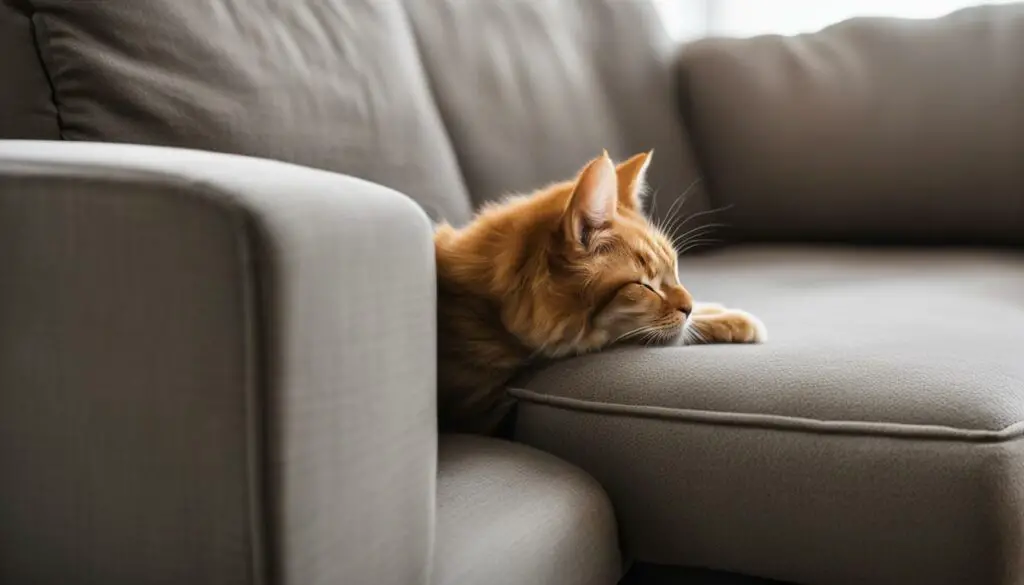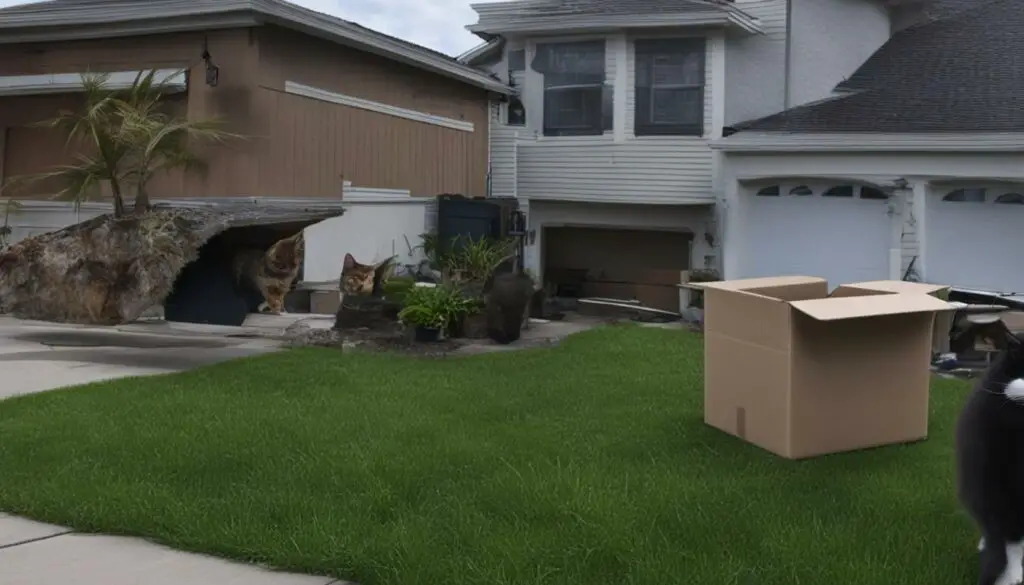Hi there! If you’ve recently moved to a new home and noticed that your cat is refusing to eat, you’re not alone. It’s actually quite common for cats to experience a loss of appetite after a change of environment. In this article, I’ll help you understand why your cat may be exhibiting this behavior and provide some tips on how to help them adjust.
Key Takeaways:
- Moving to a new home can cause cats to lose their appetite due to stress and the unfamiliarity of their surroundings.
- Creating a comfortable and safe acclimation room can help your cat adjust more easily.
- Offer a variety of wet and dry foods to entice your cat to eat.
- Spending time with your cat in their safe space and maintaining their regular feeding schedule can make them feel more secure.
- If your cat goes too long without eating or shows other signs of illness, it’s best to consult a veterinarian.
Common Behaviors in Cats After Moving
After moving to a new home, cats may exhibit various behaviors as a response to the change in environment and the stress associated with it. It’s important to understand and address these behaviors to help your feline friend adjust and feel more comfortable in their new surroundings.
Cat Hiding: One common behavior in cats after moving is hiding. Your cat may seek out secluded areas such as closets, under beds, or behind furniture as a way to feel secure. It’s essential to provide hiding spots or safe spaces in your home where your cat can retreat to when they feel overwhelmed or anxious.
Cat Attacking During Play: Another behavior you may notice is aggression during play. Cats may become more reactive or aggressive when engaging in play after a move. This can be due to heightened stress levels or a defensive response to unfamiliar stimuli. It’s important to provide plenty of interactive toys, redirect their energy towards appropriate outlets, and give them time to adjust and feel more at ease.
Cat Not Eating: Along with hiding and attacking during play, some cats may also experience a temporary loss of appetite after moving. This can be attributed to stress and anxiety. Ensuring a quiet and calm space for your cat to eat, offering a variety of appealing and familiar foods, and maintaining a regular feeding schedule can help encourage them to eat again.

Understanding these common behaviors in cats after moving can help you provide the necessary support and comfort to help your furry friend adjust to their new home. While it may take time for your cat to fully settle in, with patience, love, and consistent care, they will soon feel more at ease and adapt to their new surroundings.
Reasons Why Cats Stop Eating After Moving
When cats are faced with a move to a new home, it’s not uncommon for them to experience a loss of appetite. This can be attributed to a variety of reasons, including the stress and anxiety that comes with the unfamiliarity of their new surroundings.
The change in routine, loss of familiar smells, and disruption in their environment can all contribute to a decrease in appetite. Cats are creatures of habit, and any major change can throw them off balance. It’s important to understand these reasons so that we can provide the necessary support and help our feline friends feel comfortable in their new home.
The first and most obvious reason why cats may stop eating after moving is stress. Cats are sensitive animals, and a move can be a highly stressful event for them. The upheaval of their familiar territory and the introduction to a new environment can cause them to feel anxious and unsettled. This can lead to a loss of appetite as they struggle to adapt to their new surroundings.
Another reason why cats may stop eating after moving is the unfamiliarity of their new surroundings. Cats rely heavily on their sense of smell, and a change in scent can be disorienting for them. The loss of familiar smells that they associate with food can make eating a less desirable activity for them. Additionally, the disruption in their routine and the loss of their usual feeding area can also contribute to their lack of appetite.
| Reasons for Cat Not Eating After Moving |
|---|
| Stress and anxiety caused by the move |
| Unfamiliarity of the new environment |
| Loss of familiar smells and disruption in routine |

Quote: “Cats are creatures of habit, and any major change can throw them off balance.”
How Long Does It Take for Cats to Adjust After Moving?
Adjusting to a new home can be a challenging time for cats, and the length of the adjustment period can vary from cat to cat. Some cats may feel comfortable in their new surroundings within a day or two, while others may take longer to adapt. It is important to be patient and give your cat the time they need to settle in.
During this adjustment period, you may notice changes in your cat’s behavior, such as increased hiding, decreased appetite, or reluctance to explore their new surroundings. These are normal responses to the stress and unfamiliarity of the new environment. Providing a consistent routine, familiar objects, and plenty of attention and reassurance can help speed up the adjustment process.
It’s important to remember that every cat is unique, and their adjustment period may be influenced by factors such as age, temperament, and previous experiences. While some cats may quickly adapt to their new home, others may take weeks or even months to fully settle in. By creating a calm and secure environment, giving your cat time to explore at their own pace, and offering plenty of love and patience, you can help your feline friend adjust to their new home.

Tips to Help Your Cat Adjust After Moving
When moving to a new home, it’s important to help your cat adjust to their new environment. Here are some tips to make the transition smoother for your feline friend:
Create a Safe and Comfortable Space
Set up a designated area in your new home where your cat can feel safe and secure. This could be a spare room or a quiet corner with their bed, litterbox, and toys. Make sure they have access to food and water as well. Gradually introduce them to the rest of the house once they have become comfortable in their safe space.
Provide Familiar Objects
Having familiar objects around can help your cat feel more at ease. Place their favorite toys, blankets, and scratching posts in their acclimation room. These familiar scents will provide a sense of comfort and familiarity during the adjustment period.
Maintain a Regular Feeding Schedule
To help your cat feel secure, stick to their regular feeding schedule. Cats thrive on routine, and keeping their mealtimes consistent can provide a sense of stability. Make sure to provide a balanced diet and offer a variety of wet and dry foods to cater to their preferences.
Offer Plenty of Attention and Reassurance
During this transition, your cat may need extra love and attention. Spend time playing with them, grooming them, and offering gentle reassurance. This will help them feel more comfortable in their new surroundings and strengthen the bond between you.

Consider Using Calming Aids
If your cat is particularly anxious or stressed after the move, you may want to consider using calming aids. Pheromone diffusers or natural remedies can help create a soothing atmosphere and reduce stress levels. Consult with your veterinarian for recommendations on safe and effective calming products.
Remember, every cat is unique, and it may take some time for them to fully adjust to their new home. Be patient, understanding, and provide lots of love and support during this transition period. With the right care and attention, your cat will soon feel right at home in their new surroundings.
Signs of Stress in Cats After Moving
When cats experience the stress of moving to a new home, they may exhibit various signs of stress. It is important for cat owners to recognize these signs in order to provide the necessary support and help their feline friends adjust to their new environment.
Common Signs of Stress in Cats After Moving:
- Excessive grooming
- Increased hiding
- Excessive vocalization
- Changes in behavior
Stressed cats may engage in excessive grooming as a way to cope with anxiety, which can lead to skin irritation or hair loss. They may also hide more frequently, seeking refuge in secluded spots to feel safe. Excessive vocalization, such as meowing or crying, is another sign of stress in cats after moving. Additionally, cats may exhibit changes in behavior, such as aggression, litterbox aversion, or decreased appetite.
“Excessive grooming, increased hiding, excessive vocalization, and changes in behavior are all common signs of stress in cats after moving.”
It is important to create a calm and secure environment for stressed cats, providing hiding spots and comforting spaces where they can retreat. Bonding with your cat through playtime, grooming, and cuddling can also help alleviate stress and build trust. If the signs of stress persist or worsen, it is advisable to consult a veterinarian for further guidance and support.

| Signs of Stress | Description |
|---|---|
| Excessive grooming | Cats may groom themselves excessively as a way to cope with stress. This can lead to skin irritation or hair loss. |
| Increased hiding | Cats may seek out hiding spots more frequently to feel safe and secure in their new environment. |
| Excessive vocalization | Stressed cats may meow or cry more than usual as a way to express their anxiety. |
| Changes in behavior | Stress can cause cats to exhibit changes in behavior, such as aggression, litterbox aversion, or a decrease in appetite. |
Dealing with Litterbox Problems After Moving
One common issue that cats may experience after moving to a new home is difficulty using the litterbox. This can be attributed to the stress and unfamiliarity of the new environment. If your cat is not using the litterbox, there are several steps you can take to address this problem and help them adjust.
Creating a Suitable Environment:
First, ensure that your cat has easy access to multiple litterboxes placed in different areas of the house. This will provide them with options and increase the likelihood of them using the litterbox. It is also crucial to use the same type of litter that your cat is familiar with, as a sudden change in litter can be confusing and discourage them from using it.
Proper Litterbox Maintenance:
Regularly clean and maintain the litterboxes to keep them fresh and inviting for your cat. Cats are generally clean animals and may avoid using a dirty litterbox. Scoop the litter daily and completely change the litter at least once a week. Additionally, consider using a litterbox liner or mat to make cleanup easier and prevent litter from being tracked throughout the house.
Consulting a Veterinarian:
If your cat continues to have litterbox problems despite providing a suitable environment and proper maintenance, it’s recommended to consult a veterinarian. They can help determine if there is an underlying medical issue causing the behavior and provide appropriate guidance and treatment. In some cases, medical conditions such as urinary tract infections or bladder stones may contribute to litterbox issues.
| Common Reasons for Litterbox Problems After Moving | Solutions |
|---|---|
| Stress and anxiety from the move | Provide a quiet and secure area for your cat, and consider using pheromone diffusers or calming aids to help reduce stress. |
| Unfamiliarity with the new litterbox location | Place multiple litterboxes in different areas of the house, and gradually move them to the desired permanent location. |
| Competition or conflict with other cats in the household | Ensure that each cat has their own designated litterbox and provide separate feeding and resting areas. |
| Unpleasant past experiences in the litterbox | Clean the litterbox regularly and provide a comfortable and inviting environment for your cat. |
Remember, patience and consistency are key when addressing litterbox problems. By creating a suitable environment, maintaining the litterboxes properly, and seeking professional guidance if needed, you can help your cat adjust and overcome litterbox issues after moving.

Managing Scratching Behavior After Moving
Moving to a new home can be an exciting time for you and your feline companion. However, one common challenge that many cat owners face after a move is managing scratching behavior. Cats have a natural instinct to scratch, which helps them stretch their muscles, mark their territory, and shed the outer layer of their claws. Unfortunately, this behavior can sometimes lead to damage to furniture and other household items. To prevent this, here are some tips for managing scratching behavior after moving:
- Provide appropriate scratching surfaces: Cats need a designated place to scratch, so make sure you have scratching posts or pads available in the areas where your cat is most likely to scratch. These surfaces should be tall enough for your cat to fully extend their body, and sturdy enough to withstand scratching. You can also try different textures, such as sisal, carpet, or cardboard, to see which one your cat prefers.
- Use deterrents: If your cat is consistently scratching furniture or other off-limits areas, you can use deterrents to discourage this behavior. Double-sided tape or aluminum foil can be placed on the furniture to make it less appealing to scratch. There are also commercial sprays available that have an unpleasant scent for cats, which can deter them from scratching.
- Regular nail trims: Keeping your cat’s nails trimmed can help minimize the damage caused by scratching. Use cat-specific nail clippers and trim the very tip of each nail, being careful not to cut into the quick. If you’re unsure how to trim your cat’s nails, consult your veterinarian or a professional groomer for guidance.
- Environmental enrichment: Providing your cat with plenty of mental and physical stimulation can help redirect their scratching behavior. Interactive toys, puzzle feeders, and regular play sessions can keep your cat engaged and satisfied. Additionally, providing vertical spaces, such as cat trees or shelves, can give your cat an alternative place to climb and scratch.
“Cats need a designated place to scratch, so make sure you have scratching posts or pads available in the areas where your cat is most likely to scratch.”
Remember, it’s important to never punish your cat for scratching. Instead, focus on providing them with appropriate outlets for this natural behavior. With consistency, patience, and the right tools, you can help manage your cat’s scratching behavior and protect your furniture in the process.

Table: Comparison of Different Types of Scratching Surfaces
| Type of Scratching Surface | Pros | Cons |
|---|---|---|
| Sisal | – Durable and long-lasting – Provides a satisfying texture for scratching |
– Can be messy as it sheds fibers – May not be as visually appealing |
| Carpet | – Mimics the texture of household surfaces – Can be more visually appealing |
– Can become worn and frayed over time – May attract cats to other carpeted areas in the home |
| Cardboard | – Inexpensive and readily available – Provides a satisfying texture for scratching |
– Prone to shredding and may need frequent replacement – Not as visually appealing as other options |
Coping with Cat Aggression After Moving
Adjusting to a new environment can be a stressful experience for cats, and it’s not uncommon for them to exhibit aggression as a result. Cat aggression after moving can manifest in various ways, including biting during petting or play. Understanding and addressing this behavior is essential to ensure a harmonious transition for both you and your feline companion.
One possible cause of cat aggression after moving is fear or anxiety stemming from the unfamiliar surroundings. To help your cat cope, create a safe space where they can retreat and feel secure. This can be a designated room or a cozy hiding spot with bedding and familiar objects. Allow your cat to approach you on their terms, avoiding any forced interactions that may trigger their aggression.
It’s important to pay attention to your cat’s body language before and during interactions. If your cat starts displaying signs of restlessness, such as flattened ears, dilated pupils, or a swishing tail, it may be a sign that they are feeling threatened or uncomfortable. Respect their boundaries by giving them space and time to adjust.
In some cases, seeking professional help from a veterinarian or animal behaviorist may be necessary. They can provide valuable insights and guidance tailored to your cat’s specific situation. Remember, patience and understanding are key when addressing cat aggression after moving, and with time and proper care, your feline friend can find comfort and security in their new home.
“Creating a safe space and respecting your cat’s boundaries are crucial when dealing with cat aggression after moving.” – Dr. Sarah Thompson, Veterinarian

Additional Tips to Manage Cat Aggression After Moving:
- Provide plenty of mental and physical stimulation through interactive play sessions and puzzle toys to help release any pent-up energy.
- Consider using pheromone diffusers or natural calming remedies to create a soothing environment for your cat.
- Establish a predictable routine and maintain consistent feeding and playtimes to reduce stress and promote a sense of security.
- Ensure your cat has access to appropriate scratching posts and provide positive reinforcement when they use them, redirecting their energy away from aggression.
- Consider implementing positive reinforcement training techniques to help redirect and modify your cat’s aggressive behavior.
Summary:
Cat aggression after moving is a common response to stress and anxiety. By creating a safe and secure environment, respecting your cat’s boundaries, and seeking professional guidance if necessary, you can help your feline companion adjust and overcome their aggression. With patience, understanding, and appropriate management strategies, your cat can find peace and harmony in their new home.
Addressing Excessive Vocalization After Moving
It is not uncommon for cats to exhibit excessive vocalization, such as meowing or crying, after moving to a new home. This behavior is often a sign of stress and anxiety as your cat adjusts to unfamiliar surroundings. Understanding how to address and manage excessive vocalization can help create a more peaceful environment for both you and your furry friend.
To address excessive meowing or crying after moving, it is important to provide a calming and secure environment for your cat. Create a designated safe space for them to retreat to, such as a cozy bed or a quiet room, where they can feel secure and relaxed. This will help alleviate their anxiety and reduce the need for excessive vocalization.
In addition to providing a safe space, engaging in regular play sessions can also help your cat release pent-up energy and reduce their stress levels. Interactive toys and playtime activities not only provide mental stimulation but also help redirect your cat’s focus away from excessive vocalization.

Ensuring a Safe Transition for Your Cat
Moving to a new home can be a stressful time for both you and your feline friend. As you prepare for the move, it’s important to prioritize your cat’s safety and well-being. Here are some essential tips to ensure a smooth and secure transition for your beloved pet:
1. Keep Your Cat Indoors
During the moving process, it’s crucial to keep your cat indoors. This will prevent them from getting lost or injured in an unfamiliar environment. Create a safe and comfortable space for them in your current home, away from the chaos of packing. Once you’ve settled into your new home, gradually introduce your cat to the outside world under your supervision and only when they are fully adjusted.
2. Secure Your New Yard
Before allowing your cat access to the outdoors in your new home, thoroughly inspect your yard for potential hazards. Remove any toxic plants or substances that could harm your cat. Ensure that your fences are secure and there are no escape routes. Taking these precautions will help keep your cat safe and prevent accidents or injuries.
3. Safely Store Hazardous Materials
Moving involves handling various household items, including cleaning products and medications, that can be harmful to your cat if ingested. Make sure to securely store these items in cabinets or drawers that are inaccessible to your cat. Additionally, keep an eye on small objects like nails or screws that can be easily swallowed. By doing so, you can prevent accidental poisoning or choking hazards.
4. Supervise Outdoor Adventures
When the time comes to allow your cat outdoor access, it’s essential to supervise their adventures. Use a leash or harness to keep them safe and prevent them from wandering too far or encountering potential dangers. By supervising their outdoor activities, you can ensure that your cat remains safe, while also giving them the opportunity to explore and become familiar with their surroundings.

Remember, moving can be a stressful experience for cats, so it’s important to provide them with a secure and comforting environment. By following these safety tips, you can help your cat adjust to their new home with ease, giving them the love and support they need during this transition.
Helping Cats Feel Secure in a New Home
Adjusting to a new home can be a challenging experience for cats. It’s important to create a sense of security and help them feel at ease in their new surroundings. Here are some tips to help your cat feel secure in a new home:
- Create a Comforting Environment: Provide plenty of hiding spots, such as cat trees or cozy beds, where your cat can retreat when they feel anxious or overwhelmed.
- Use Pheromone Diffusers: Consider using pheromone diffusers or calming sprays in your home. These products release synthetic pheromones that can help create a soothing and familiar environment for your cat.
- Bond through Playtime and Grooming: Spend quality time bonding with your cat through interactive play sessions and regular grooming. This helps build trust and strengthen the bond between you and your cat.
Remember, each cat is unique and may require different strategies to feel secure in a new home. Take the time to observe your cat’s behavior and adjust your approach accordingly.
By providing a secure environment, using pheromone diffusers, and spending quality bonding time, you can help your cat adjust to their new home and feel more secure in their surroundings.

| Benefits of Creating a Secure Environment | Tips to Help Your Cat Feel Secure |
|---|---|
| Reduces stress and anxiety | Create hiding spots |
| Enhances your cat’s overall well-being | Use pheromone diffusers |
| Strengthens the bond between you and your cat | Bond through playtime and grooming |
Recognizing When to Consult a Veterinarian
While it is common for cats to experience appetite loss and behavioral changes after moving to a new home, it is important to monitor their overall health during this adjustment period. In some cases, these changes may be indicative of underlying medical issues or severe stress. To ensure the well-being of your cat, there are certain signs that indicate it may be time to consult a veterinarian.
If your cat refuses to eat for more than two days, it could be a cause for concern. Cats are typically resilient creatures, but a prolonged loss of appetite can lead to serious health complications. Additionally, if your cat shows signs of illness such as vomiting, diarrhea, or lethargy, it is important to seek veterinary attention. These symptoms could be related to stress or could indicate another underlying health issue that requires medical intervention.
Severe stress-related behaviors are another indication that it may be time to consult a veterinarian. While it is normal for cats to exhibit temporary changes in behavior after a move, persistent aggression, excessive vocalization, or destructive behavior may be a sign that your cat is struggling to adapt. A veterinarian can evaluate your cat’s behavior, assess their overall well-being, and provide guidance on how to alleviate their stress and promote a healthy adjustment.
In summary, if your cat is not eating for an extended period of time, showing signs of illness, or exhibiting severe stress-related behaviors, it is advisable to consult a veterinarian. They can provide a comprehensive evaluation, diagnose any underlying medical issues, and provide appropriate treatment or guidance to ensure the best possible outcome for your feline friend.
Conclusion
After moving to a new home, it’s not uncommon for cats to experience a loss of appetite and exhibit behavioral changes. This is primarily due to the stress and unfamiliarity of their new environment. However, there are several strategies you can employ to help your cat adjust and regain their appetite.
Firstly, providing a comfortable and safe acclimation room can give your cat a sense of security during the transition period. This room should be equipped with their favorite toys, bedding, and familiar objects from their previous home. Additionally, offering a variety of wet and dry foods can entice your cat to eat, as their preferences may change during this time of adjustment.
Spending time with your cat in their safe space and gradually introducing them to other areas of the home can help alleviate their stress. Monitor your cat closely to ensure they are eating and adjust their feeding schedule if necessary. If your cat refuses to eat for more than two days, shows signs of illness, or exhibits severe stress-related behaviors, it is important to consult a veterinarian for further guidance and support.
Remember, patience is key when helping your cat adjust to their new surroundings. By providing a comforting and familiar space, maintaining their routine, and seeking professional help when needed, you can ensure a smooth transition for your beloved feline companion.
FAQ
Why is my cat not eating after moving?
Cats may experience appetite loss due to stress, anxiety, or the unfamiliarity of their new surroundings.
How long does it take for cats to adjust after moving?
The adjustment period varies, but some cats may feel comfortable within a day or two, while others may take longer.
How can I help my cat adjust after moving?
Create a safe and comfortable acclimation room, maintain their regular feeding schedule, and provide plenty of attention and reassurance.
What are the signs of stress in cats after moving?
Signs of stress can include excessive grooming, hiding, vocalization, and changes in behavior.
My cat is not using the litterbox after moving. What should I do?
Provide multiple litterboxes in accessible locations, use the same type of litter, and ensure they are clean and well-maintained.
How can I manage my cat’s scratching behavior after moving?
Provide appropriate scratching posts or pads, use deterrents on furniture, and engage in regular nail trims and environmental enrichment.
What should I do if my cat shows aggression after moving?
Pay attention to their body language, respect their boundaries, offer playtime and interactive toys, and seek professional guidance if needed.
How can I address excessive vocalization in my cat after moving?
Provide a calming environment, engage in regular play sessions, establish a routine, and seek veterinary assistance if necessary.
How can I ensure a safe transition for my cat when moving?
Keep them indoors initially, check for toxic plants in the new yard, store harmful substances securely, and supervise outdoor adventures.
How can I help my cat feel secure in a new home?
Provide hiding spots, use calming aids, spend time bonding, and offer reassurance and attention.
When should I consult a veterinarian after my cat has moved?
If your cat refuses to eat for more than two days, shows signs of illness, or exhibits severe stress-related behaviors, seek veterinary assistance.
Source Links
- https://www.hshv.org/when-problems-arise-with-your-newly-adopted-cat/
- https://www.hepper.com/cat-not-eating-after-move/
- https://petkeen.com/why-is-cat-not-eating-after-moving-to-new-home/








